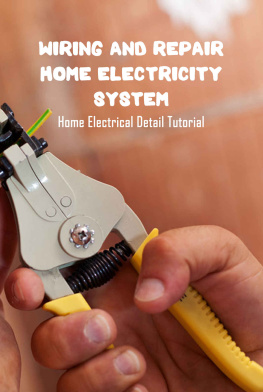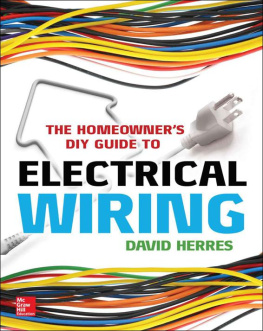
WIRING REPAIRS
Current with 2011-2013
Electrical Codes

Contents

Wiring Repair Projects

Repair and wiring are two words you dont see together too much anymore. In most cases of an electrical failure, the repair is to replace the failed device. But it may also be reconnected to a bad splice or a loose connection.
The electrical items that most frequently require actual repairs are light fixtures. If you include lamps and cords in this category, youve pretty much covered it. Most electrical failures result from poorly made connections in the original installation. Exceptions are switches, which tend to wear out over time and require replacement, and ceiling fans. Ceiling fans are unique in that, like switches, they contain moving partsand rapidly moving parts at that. Catching a switch pull chain on a moving blade is the cause of many ceiling fan problems, along with blades that have fallen out of balance and have begun to wobble.
When replacing part of an electrical fixture, the rule of thumb for finding the replacement part is to remove the broken part and bring it with you to a lighting or electrical supply store. Failing that, take down the make and serial number of the fixture so the clerk can look up part information for you.
 Repairing Light Fixtures
Repairing Light FixturesL ight fixtures are attached permanently to ceilings or walls. They include wall-hung sconces, ceiling-hung globe fixtures, recessed light fixtures, and chandeliers. Most light fixtures are easy to repair using basic tools and inexpensive parts.
If a light fixture fails, always make sure the light bulb is screwed in tightly and is not burned out. A faulty light bulb is the most common cause of light fixture failure. If the light fixture is controlled by a wall switch, also check the switch as a possible source of problems.
Light fixtures can fail because the sockets or built-in switches wear out. Some fixtures have sockets and switches that can be removed for minor repairs. These parts are held to the base of the fixture with mounting screws or clips. Other fixtures have sockets and switches that are joined permanently to the base. If this type of fixture fails, purchase and install a new light fixture.
Damage to light fixtures often occurs because homeowners install light bulbs with wattage ratings that are too high. Prevent overheating and light fixture failures by using only light bulbs that match the wattage ratings printed on the fixtures.
Techniques for repairing fluorescent lights are different from those for incandescent lights. Refer to pages to repair or replace a fluorescent light fixture.
Tools & Materials
Circuit tester
Screwdriver
Continuity tester
Combination tool
Replacement parts, as needed

In a typical incandescent light fixture, a black hot wire is connected to a brass screw terminal on the socket. Power flows to a small tab at the bottom of the metal socket and through a metal filament inside the bulb. The power heats the filament and causes it to glow. The current then flows through the threaded portion of the socket and through the white neutral wire back to the main service panel.

Before 1959, incandescent light fixtures (shown cutaway) often were mounted directly to an electrical box or to plaster lath. Electrical codes now require that fixtures be attached to mounting straps that are anchored to the electrical boxes. If you have a light fixture attached to plaster lath, install an approved electrical box with a mounting strap to support the fixture.
PROBLEM | REPAIR |
Wall- or ceiling-mounted fixture flickers or does not light. | 1. Check for faulty light bulb.
2. Check wall switch and repair or replace, if needed.
3. Check for loose wire connections in electrical box.
4. Test socket and replace, if needed (pages ).
5. Replace light fixture. |
Built-in switch on fixture does not work. | 1. Check for faulty light bulb.
2. Check for loose wire connections on switch.
3. Replace switch.
4. Replace light fixture. |
Chandelier flickers or does not light. | 1. Check for faulty light bulb.
2. Check wall switch and repair or replace, if needed.
3. Check for loose wire connections in electrical box.
4. Test sockets and fixture wires, and replace, if needed. |
Recessed fixture flickers or does not light. | 1. Check for faulty light bulb.
2. Check wall switch and repair or replace, if needed.
3. Check for loose wire connections in electrical box.
4. Test fixture and replace, if needed. |
 How to Remove a Light Fixture & Test a Socket
How to Remove a Light Fixture & Test a Socket
Turn off the power to the light fixture at the main service panel. Remove the light bulb and any shade or globe, then remove the mounting screws holding the fixture base to the electrical box or mounting strap. Carefully pull the fixture base away from the box.

Test for power by touching one probe of a circuit tester to the green grounding screw, then inserting the other probe into each wire connector. Tester should not glow. If it does, there is still power entering the box. Return to the service panel and turn off power to the correct circuit.

Disconnect the light fixture base by loosening the screw terminals. If fixture has wire leads instead of screw terminals, remove the light fixture base by unscrewing the wire connectors.










 Repairing Light Fixtures
Repairing Light Fixtures


 How to Remove a Light Fixture & Test a Socket
How to Remove a Light Fixture & Test a Socket


